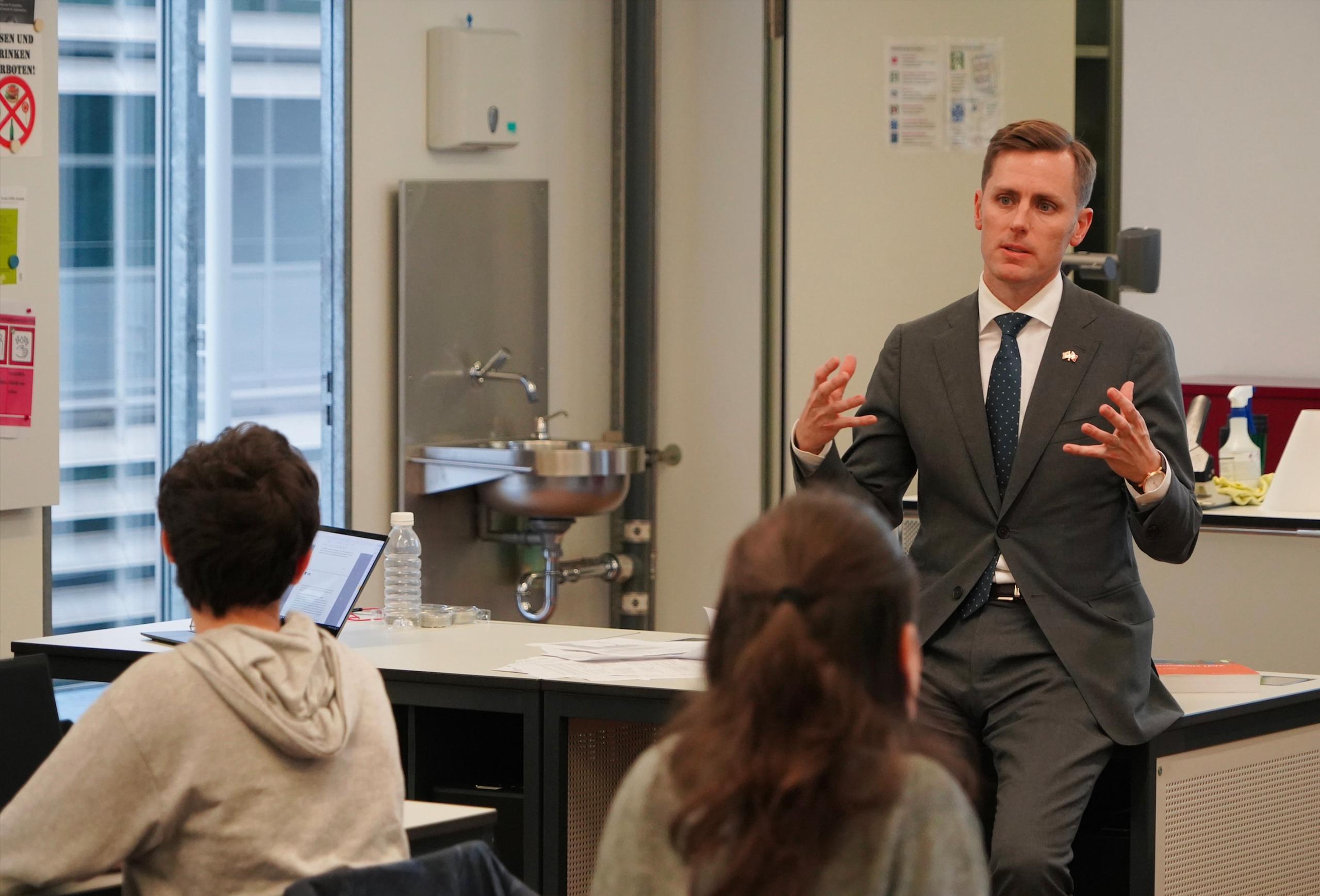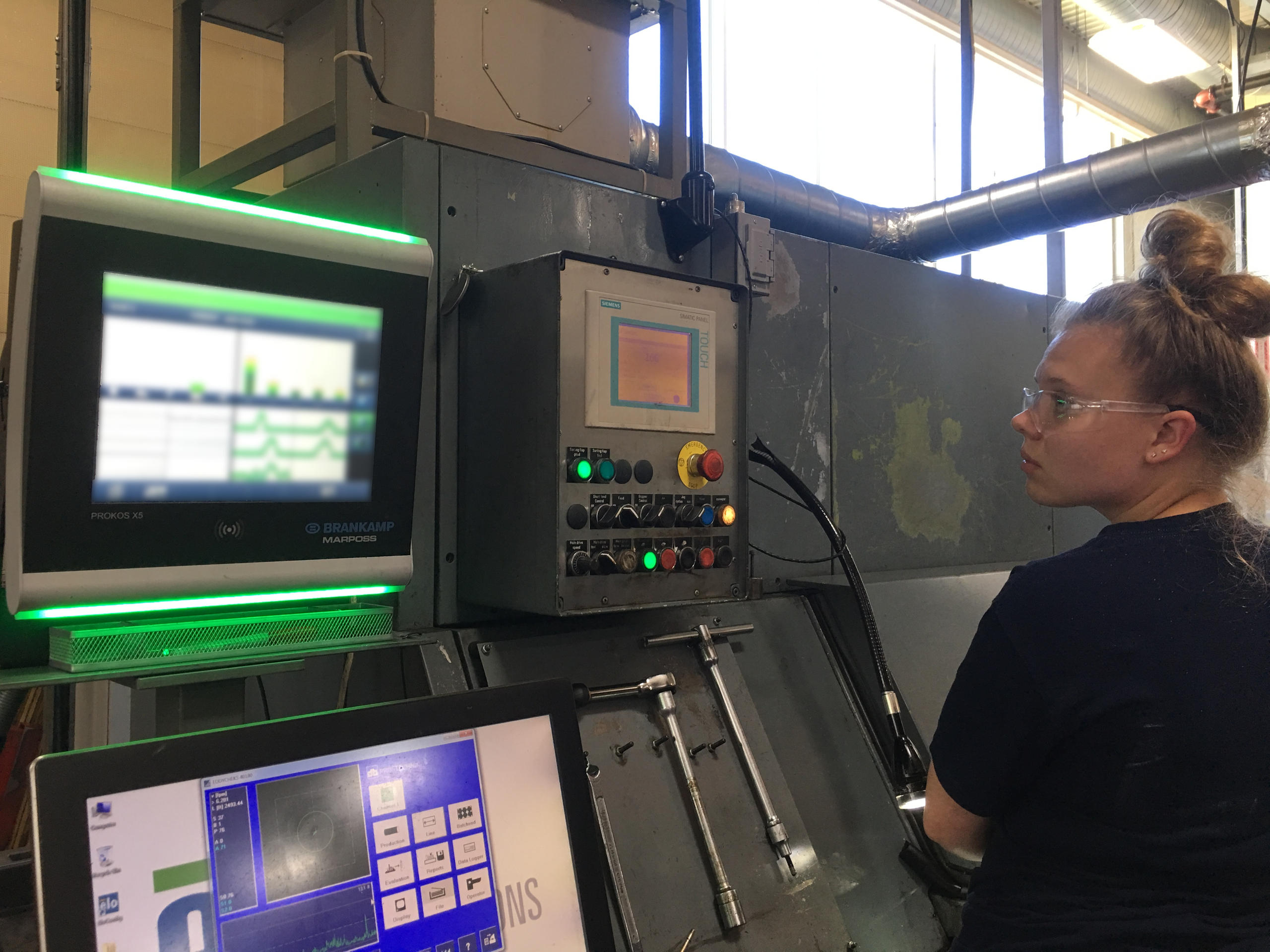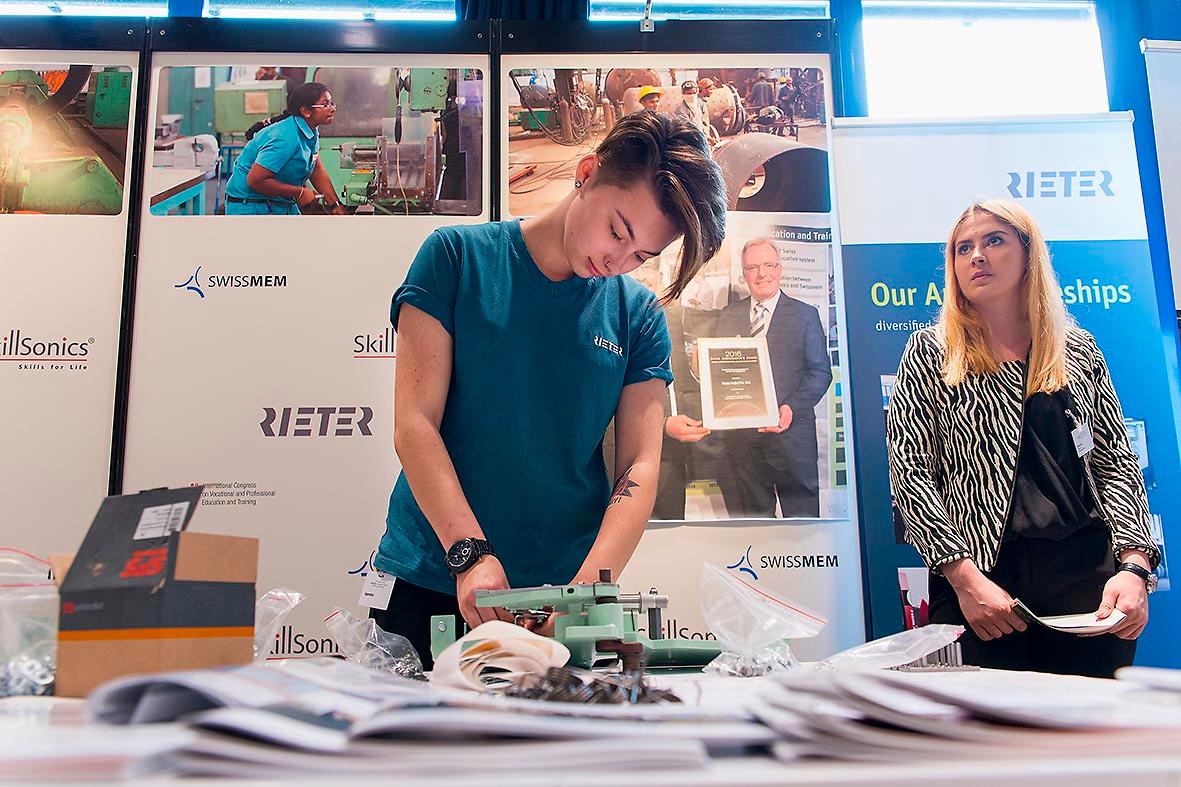US ambassador gets a dose of Swiss apprenticeships

What is it like to do an apprenticeship in Switzerland? The United States ambassador to Switzerland, Scott Miller, has been visiting a production site – and speaking to young apprentices – at healthcare firm Johnson & Johnson to find out.
Johnson & Johnson’s Janssen production facility in the northern Swiss city of Schaffhausen was the first stop on Ambassador Miller’s recent whistlestop tour of Switzerland to mark US National Apprenticeship Week, which ran November 14-20. The week, which aimed to promote vocational training and careers, saw more than 1,000 events and activities throughout the US. In Switzerland and Liechtenstein, the ambassador also visited several other companies as well as a trade school as part of his efforts to highlight Swiss and US apprenticeship programmes.
Johnson & Johnson is an American company present in Schaffhausen since 1959, where it employs 44 apprentices from aged 15 in mainly technical roles. Janssen, Johnson & Johnson’s pharmaceutical sector, is housed not far from the town centre. It is one of the major producers of the Swiss pharmaceutical industry, with its portfolio including, among others, cancer drugs.
Hygiene rules for the ambassador’s visit at the site were strict. Everyone, including the ambassador, his team and us journalists, had to don white overalls and a cap, with beard coverings for some of the men. Eye shields were also provided.
Miller started his tour at the production line, meeting apprentices like plant operator Marko, aged 20, as seen in the video below. His training runs over three years and needs special skills, as it involves operating high-tech machinery. Speaking to the ambassador, Marko says his most valuable learning has been to solve problems. “As a plant operator, you have to look, what does the machine say to you? Where’s the problem? How can I solve problems?”
Like most Swiss apprenticeships, Marko’s training is dual track, combining on-the-job training with one day a week at a trade school. As a third-year apprentice, Marko will shortly take his exams to get his federal vocational education and training (VET) diploma, which will mark the end of his apprenticeship.
Life lessons
In the logistics area, second-year apprentice Amanda Egger explained that she had started work at 7am. “It was very busy this morning,” she says, standing among shelves of pallets.
The 17-year-old clearly loves her job. “It’s basically the same [every day] but there are small differences,” she told SWI swissinfo.ch. The other advantage: “I like having responsibility.”
Giving young people more responsibility is an aspect of apprenticeships that impresses ambassador Miller. “What I love about apprenticeships is that it provides an opportunity for teenagers to have a job, to develop life skills of communication, of presentation and collaboration with team members. Ultimately it leads to a career. They can choose to go into education if they want beyond that,” he told SW during the visit. “There are infinite opportunities”.
In Switzerland, tertiary education includes higher-level vocational qualifications, which can be taken after an apprenticeship. This Swiss speciality, which prepares people for management and specialist roles, is less well known abroad.

More
Vocational training drives tertiary qualification rise in Switzerland
For a Johnson & Johnson plant operator such as Marko, this could mean obtaining an Advanced Federal Diploma of Higher Education in systems engineering or process management. Or he could go for the Federal Vocational Baccalaureate, which opens the door to universities of applied sciences, Switzerland’s more industry-oriented universities, to study mechanical engineering.
Many graduate apprentices take this route at Johnson & Johnson, either combining work and study or studying and then coming back in a different role afterwards, the company says. Overall, the apprenticeship retention rate at the company in Schaffhausen is around 80%.
Apprenticeships in the US
In the US, a country traditionally focused on college education, interest and funding for apprenticeships has been growing in recent years.
As Miller explained in a sit-down interview, President Joe Biden aims to boost the model during his presidency. His wife Jill, a community college educator, already travelled to Switzerland in 2014 under the Obama administration to learn more about the Swiss model.

More
‘If I’d had an apprenticeship offer, I’d have taken it’: US ambassador
In a proclamation for National Apprenticeship weekExternal link, Biden praised the country’s apprenticeships schemes as creating “a critical pathway to good-paying jobs”.
Singled out was the registered apprenticeships scheme, which has either state or federal approval. It operates on a much smaller scale than in Switzerland. There were almost 600,000 peopleExternal link, younger and older, employed as registered apprentices in 2021 in the US, a fraction of the working population, which reached 152.5 million in 2021. In tiny Switzerland, just over 211,000 peopleExternal link were doing apprenticeships in 2021. Vocational training is the number one choice for students after secondary school, with two-thirds taking this path.
Future skills and a path to success
Last February, the Biden administration announced $113 million (CHF108 million) in funding to expand and diversify registered apprenticeships, particularly in the domain of technology, where there is a skills shortage.
Both Miller and Johnson & Johnson underlined the importance of training to prepare for the professions of tomorrow. Johnson & Johnson, for example, will add on three new apprenticeship programmes from 2023, such as specialist maintenance and polymechanics.
But a mentality change is needed in the US to convince people that apprenticeships are a viable alternative to college, and not just limited to “blue collar” trades. Miller hopes that bilateral cooperation on apprenticeships will play a role in changing hearts and minds. Thirty Swiss companies provide 400 apprenticeships in the US – an important export, Miller said. American companies in Switzerland with their own schemes also set an example, he added.
Key to all this is the memorandum of understanding (MOU) on vocational education, which was renewed by Bern and Washington in November 2021 to boost cooperation in the domain. It was kick-started by one of Miller’s predecessors, Suzi LeVine, in 2015, and provoked a flurry of visits from the US delegations to learn more about apprenticeships in Switzerland. The MOU has also inspired several state-led schemes.
The latest MOU will promote the exchange of ideas and best practices for expanding apprenticeship programmes in both countries.
And as Miller stressed during the interview, apprenticeships should be no barrier to success. “I always point out to the [US] administration, here in Switzerland four of the seven current cabinet ministers did an apprenticeship,” he said.

In compliance with the JTI standards
More: SWI swissinfo.ch certified by the Journalism Trust Initiative













You can find an overview of ongoing debates with our journalists here . Please join us!
If you want to start a conversation about a topic raised in this article or want to report factual errors, email us at english@swissinfo.ch.